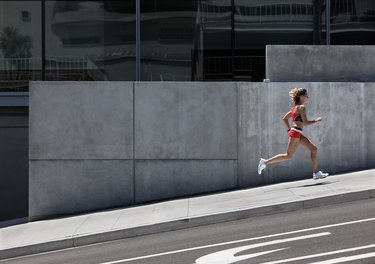
Whether you use a treadmill in the gym or climb a hill in the great outdoors, walking on an incline is a great low-impact cardio workout. It may help prevent or manage the symptoms of osteoarthritis in your knees. It taxes not only your cardiovascular system but also several muscles throughout your lower body and even a few in your upper body.
Tip
All of the major muscles in your lower body are recruited when you're walking up an incline. Quite a few in your core and upper body are needed as well.
Video of the Day
What the Quads Do
The quadriceps is a group of four muscles — the rectus femoris, vastus lateralis, vastus medialis and vastus intermedius — that work together to extend the leg at the knee.
Video of the Day
When walking on an incline, your quadriceps work to straighten your leading leg. The rectus femoris also crosses the hip joint, helping to bring your back leg forward.
The Hamstrings' Role
The biceps femoris, semitendinosus and semimembranosus make up the hamstring muscles on the back of the thigh. These muscles work together to extend the thigh and flex the knee.
While you're walking on an incline, your hamstrings primarily work to extend the thigh on your leading leg as you move your back leg to the front.
Glutes Do Double Duty
The gluteus maximus works with the hamstrings to extend the thighs while you're walking on an incline. The greater the incline, the more your gluteus maximus and hamstrings must work.
The gluteus medius and gluteus minimus work to stabilize the pelvis, preventing one side from sagging and thus allowing the swinging limb to clear the ground.
Lower Leg Muscles
You work all of the muscles of the lower legs when walking on an incline. The muscles on the front of the lower leg work together to lift your toes and the front of your foot off the ground as you bring your back leg to the front.
You work the calf muscles on the back of the lower leg more intensely walking on an incline than when walking on a level surface. Your calves work as you push your foot away from the ground at the end of your stride.
The Secondary Muscles
While walking is primarily a lower body exercise, you also work a few muscles in your upper body. You work your abdominal and back muscles constantly to keep your torso upright, especially as the incline increases.
ou work the muscles in your shoulders and upper arms as you perform the natural arm-swinging motion that accompanies walking.
Other Stuff to Know
Backward walking on a treadmill inclined has become "popular" amongst the athletic crowd because of its tendency to build quads like a speed skater's. But it has been definitively proven through a 2014 study conducted at the University of Las Vegas to increase flexibility in your hamstrings.
Remember that you don't have to —but they're there for you to try — use the pre-programmed workouts on your treadmills. They'll take you fast and slow and up hills. But you can plan an incline workout that is totally customizable to your health and fitness needs according to Harvard Health Publishing.